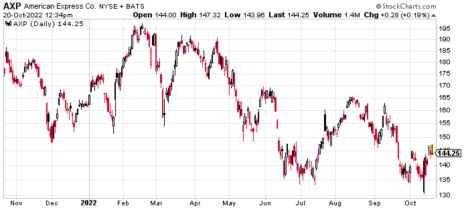Cabot Options Institute Earnings Trader – Alert (AXP)
As discussed in our weekly issue last week, and on our weekly call, I will be taking a position in American Express (AXP) today.
American Express is due to announce before the opening bell Friday.
Iron Condor Earnings Trade in American Express (AXP)
AXP is currently trading for 144.25. Let’s examine an iron condor trade with a high probability of success.
First, let’s take a look at the expected move in AXP for the expiration cycle that I’m interested in. Since AXP is due to report late in the week, I want to go out at least one additional week, in this case to the October 28 expiration cycle.
The expected move or expected range over the next 8 days can be seen in the pale, orange-colored bar below. The expected move is from 137 to roughly 152, for a range of 15.
Knowing the expected range, I want to place the short call strike and short put strike of my iron condor outside of the expected range, in this case outside of 137 to 152.
This is my preference most of the time when using iron condors.
If we look at the call side of AXP for the October 28, 2022, expiration, we can see that the 157.5 call strike offers a 91.65% probability of success. So, I’m going to sell the short call at the 157.5 call strike and define my risk with the 162.5 call strike. By choosing the 162.5 call strike to define my risk, I know that there is less than a 4% chance that I will take a max loss on the trade.
Now let us move to the put side. Same process as the call side. But now we want to find a suitable strike below the low side of our expected move, or 137. The 133 put strike, with an 84.78% probability of success, works. I’m going to define my risk by choosing the 128 put strike with a 92.68% probability of success. This means we have less than an 8% chance of taking a max loss on the downside.
We can create a trade with a nice probability of success if AXP stays between our 24.5-point range, or between the 157.5 call strike and the 133 put strike. Our probability of success on the trade is 91.65% on the upside and 84.78% on the downside.
I like those odds. The question is, will the premium be enough to make the trade worth the risk? Let’s take a look.
Here is the trade:
Simultaneously:
Sell to open AXP October 28, 2022, 157.5 callsBuy to open AXP October 28, 2022, 162.5 callsSell to open AXP October 28, 2022, 133 putsBuy to open AXP October 28, 2022, 128 puts for roughly $0.70 or $70 per iron condor (prices will fluctuate, please adjust accordingly if you wish to enter trade)
Our potential return on the trade: 16.3%
Our margin requirement is $430 per iron condor.
Again, the goal of selling the AXP iron condor is to have the underlying stock stay below the 157.5 call strike and above the 133 put strike immediately after AXP earnings are announced.
Here are the parameters for this trade:
- The Probability of Success – 91.65% (call side) and 84.78% (put side)
- The maximum return on the trade is the credit of $0.70, or $70 per iron condor
- Breakeven level: 158.20 – 132.30
- The maximum loss on the trade is $430 per iron condor. Remember, we always adjust if necessary, and always stick to our stop-loss guidelines.
*Also, proper position size is the KEY to long-term success when trading earnings. Keep your size within reason and allow the law of large numbers to do the work. Losses will occur, so manage your position via position size accordingly.




